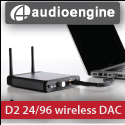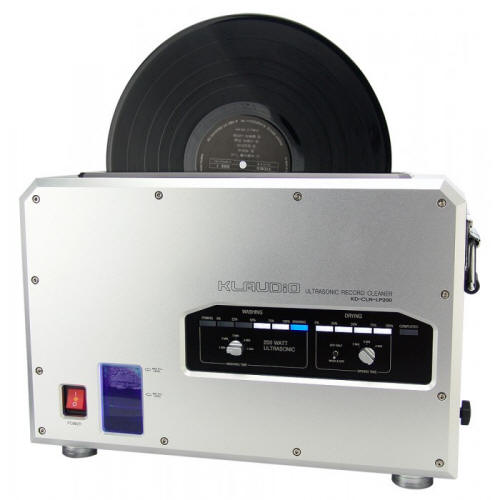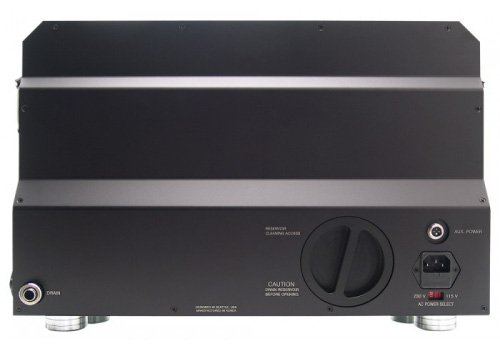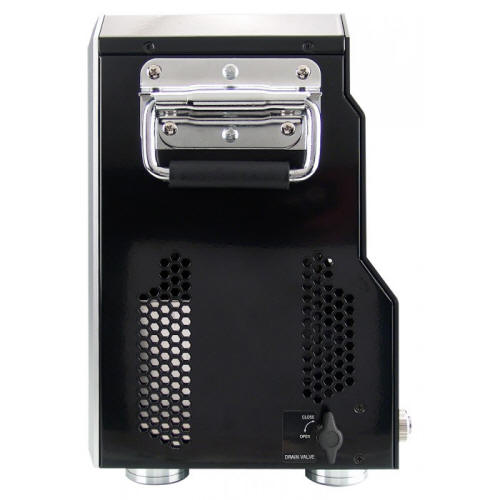|
|
You are reading the
older HTML site
Positive Feedback ISSUE 69
klaudio KD-CLN-LP200 Record Cleaning Machine - Breaking the Sound Barrier as reviewed by Myles B. Astor
Want to drive an vinyl junkie insane? Just ask them if they're sure their records are absolutely clean! Be prepared, however, for them to immediately, if not sooner, launch into at least a half hour diatribe about the time honored ritual (s) they go through before playing their LPs. But if the newest generation of ultrasound based (US) record cleaning machines are any indication, their efforts may be falling short of the mark and many vinyl junkies are losing a significant fraction of the information encoded into those record grooves. Sonics notwithstanding, scrub and vacuum record cleaning machines have promised ever since the very first Percy Wilson design the elimination of those annoying pops and tics and a drop in record surface noise from new and used albums. That admittedly somewhat lofty goal has, with conventional scrub and vacuum record cleaning machines, not been entirely successful. Some of the newer enzyme based record cleaning solutions—that coincidentally also impart less of their sonic character on the music—have brought "conventional" record cleaning machines one step closer to realizing this goal. Sonically, both the recently reviewed Audio Desk Systeme and the currently under review Klaudio ultrasonic cleaning machines are cut from the same sonic cloth. Both machines produce a precipitous reduction in the record's noise floor accompanied by a corresponding increase in transparency and image density. Images are not unlike what one experiences listening to a good 15-ips reel-to-reel tape. Instruments are simply more palpable and locked in their own space; you're literally transported back to the space where the musicians are performing. Interestingly, both reference and less than reference records undergo an amazing transformation after a pass through the Klaudio. While it's said you can't make a silk purse out of sow's ear, that's not exactly true for less than reference quality LPs such as Peter Gabriel's Biko (Charisma Records CB 37012) or Stevie Winwood's Back in the High Life (Island Records 1-25447-1), two albums recently acquired at the Capital AudioFest. Uncleaned, these albums sounded like Mississippi Delta mud; vocals sounded like someone hung a thick, wool sock over the mikes. After sonicating the albums with the Klaudio machine, Gabriel and Winwood miraculously emerged from behind that sonic curtain. Lows—well, what lows there are on this pair of albums—are also improved. In addition, individual instruments are better separated and placed within the soundstage. No, US cleaning won't decompress compressed recordings nor get rid of all surface noise but it's a good start. Operation and comments Peter Cheon, the Klaudio record cleaning machine designer, has a well-earned reputation within the audiophile community as a hardcore vacuum tube and vinyl lover. Unhappy with current record cleaning machine offerings and aided in his quest by the fact that Koolance, his "real" company already manufactures many of the parts used in the record cleaning machine, Peter set about designing his own machine. Design on the unit began about 3½ years ago with the first prototypes arriving about a year ago. Top among Peter's design considerations was ensuring that the ultrasound machine didn't while going through the cleaning process also damage the record. To ensure his machine didn't damage the record, Peter employed an accelerated aging process using a colored record and modified record cleaning machine replete with a specially designed circuit board and temperature controlled water bath. He then proceeded to continuously clean the colored for nine straight hours (the equivalent of roughly 108 cleanings) at 40oC. Following the continuous nine hour cleaning, Peter failed to detect any evidence of vinyl particles in the stainless steel water reservoir. Nor did I find anything in the water reservoir after cleaning around 75 records or so. At the same time, Peter was determined this new record cleaning machine be as fully automated as possible (including an auxiliary power attachment for a yet to be announced accessory). In fact, the Klaudio is to record cleaning machines what remote controls are to line stages. Once you use either one, there's simply no going back.
The heart and soul of the 200-watt Klaudio record cleaning machine are 4 x 40kHz transducers; two transducers are used per record side and are aimed directly at the record. Peter explained the reason for choosing the 40kHz transducers was quite simple. To begin with, "these transducers are more common and field tested in the industry than 100kHz+ transducers." Next, "these transducers have a more reliable driver circuit." Finally, "they are not as costly as the high frequency ultrasonic transducers." "Another disadvantage to using a higher frequency transducer," added Tim Hunting, Peter's special assistant on assignment from the parent company Koolance, "is that the cavitation ‘balls' are much smaller and expend less energy." Peter also didn't find," according to Tim, "much of a difference in LP cleaning quality between the 40kHz and the 100kHz." Currently, the Klaudio only cleans 12-inch black discs although adapters for smaller size records may be down the road. Now unlike the Audio Desk Systeme record cleaning machine that requires a special fluid to augment the machine's ultrasound effects, the Klaudio cleans the LPs with straight up distilled water. Filling the Klaudio's water reservoir with the manufacture supplied filling funnel proved, however, a more of a challenge. (See the Klaudio website for a short video illustrating the proper way to set up, fill and drain the water from the machine along with some microscope pictures of a record grooves before and after a 4 minute sonication cleaning.) Because of the funnel's size, it was near impossible to pour directly from the distilled water jug into the machine without any spillage; probably best procedure, though slightly more cumbersome and time consuming, is to first transfer the distilled water into a measuring cup and then pour the water into the funnel. The Klaudio, depending on the percentage of new vs. used albums, will clean 50 to 100 LPs before needing a water change (unlike the Audio Desk Systeme, the Klaudio doesn't use a water filter). A backlit window into the welded steel reservoir allows for checking the machine's water level; the blue light, though, isn't kind to older eyes.
Then once the water tank is full, simply select the desired cleaning and drying times (2-3-4-5 minutes of cleaning and 2-3-4 minutes of drying), gently insert LP into the POM acetal lined slot (polyoxymethylene –an acetal resin thermoplastic based on formaldehyde polymerization technology) and it's off to the 33⅓ (or 45) rpm races. ). In contrast to the Audio Desk Systeme, the record always seats properly in Klaudio and rotates the LP. The Audio Desk Systeme will on occasion, especially with thicker records, require reseating the record so the record rotates properly. One nice value added feature of the Klaudio is the light display on the side of the machine that lets the user know how much cleaning/drying time remains (representing percentage cleaning left 0-25-50-75-100%-draining remaining in cleaning cycle). Fresh out of the box, Klaudio machine needed about 10-20 LPs to fully break-in. Initially, the Klaudio didn't consistently wet the records; that issue then disappeared soon after. No matter, the Klaudio doesn't wet the record like conventional record cleaning machines or even the Audio Desk Systeme record cleaning machine. Consequently, the freshly blasted records dry in far less time than takes less time than it takes with the Audio Desk Systeme machine. Each and every record came out perfectly dry using the 2 minute cleaning cycle. (I've not had any issue with my Audio Desk Systeme though others have reported drops occasionally being left on records.) In fact, the records were basically dry after one minute so 2 minutes might even be overkill. At the end of the cleaning cycle, the machine beeps and then every 15 secs thereafter just to remind to the owner to remove the record. The Klaudio always seemed up to the challenge of cleaning any record ranging from paper thin dynawarp jobs to those thick 200 gram slabs of vinyl. That said, the KLaudio won't always remove—like an Audio Desk Systeme or VPI machine—all the surface schmootz that can obviously be picked up by the stylus. According to the folks at Klaudio, "the transducers are working on loosening up the caked-in grime and dust which has settled into the grooves and against the vinyl." Tim suggested a squirt of compressed air or a quick wipe with a microfiber cloth prior to cleaning for records with pet hairs or other surface debris should do the trick. One addition note. Like the Audio Desk Systeme, records cleaned with the Klaudio still on rare occasion gunked up the cartridge stylus. The only thing that I can think this is due to is that the record was treated with some agent like Last. Finally, it's also impossible to talk about record cleaning machine without addressing the bane of their existence: noise. While the Klaudio's noise levels aren't all that different than the Audio Desk Systeme (just a different frequency), it is much quieter than the "conventional" VPI brush and dry record cleaning machines that have passed through (Klaudio supplied figures are 65dBA for washing and 75dBA cleaning). That said, the Klaudio machine will still be exiled to another room while playing music. One other thing worth mentioning, though, is that Klaudio sounds like it's sparking—or bringing Frankenstein to life—when it goes through its ultrasonic cleaning cycle. One thing is for sure though. My cats don't like the sound one iota.
Sound Begets Sound As pointed out in the earlier Audio Desk Systeme review, new and used records alike clearly and unquestionably benefit from a good ultrasonic cleaning. The Klaudio US machine appears to get more and more grime out of the record grooves—as well as increasing stylus/groove wall scanning contact time—resulting in more detailed bass, greater information retrieval, less smearing of transients, better instrumental dimensionality and greater retrieval of ambient space (although one wonders how much of the sonic differences between the two ultrasonic machines is traceable to the Audio Desk Systeme's cleaning/surfactant fluid). A recently purchased spare copy of Cage's Pulse (New World Records NW316) serves quite nicely to illustrate the Klaudio's sonic benefits. Two and preferably four (see next section) minutes of sonic blasting in the Klaudio first and foremost significantly reduced the record's noise floor allowing one to hear more of and into the ringing and decay of percussion instruments. And as is the trademark of US cleaners, this drop in the noise floor gives images a far greater sense of three-dimensionality and just a reach out and touch palpability to all of the percussion instruments. As a result, instruments just seem to literally pop out from their surroundings. In addition, sonicating really cleaned up the recording's upper octaves, increased the sense of transparency, gave a greater sense of RCA Studio B's space and resulted in both more defined and tighter bass. Or take the fine jazz guitar recording of Barney Kessell and Herb Ellis Poor Butterfly (Concord CJ-34). After ultrasonic cleaning, there's less of an inclination to turn the volume up to get that elusive three-dimensional quality and low level information. In addition, for whatever the reason, cleaning also resulted in a reduction of that "plasticy" Saran wrap Concord coloration (curiously absent from their tapes). Freshly minted albums such as the Classic Records release of Kenny Burrell's Blue Lights Vol. 2 (Classic Records/Blue Note 1597) also greatly benefit from a pass through the Klaudio machine. (Why hasn't any other label other than Classic Records seen fit to re-issue this recording? There doesn't appear to be any issues with the original masters.) In any case, another amazing sounding Rudy van Gelder recording is only made better with a thorough cleaning. As with the John Cage, cleaning produces an enhanced sense of quietness and transparency, particularly the ability to "see and feel" Art Blakey's drums in the back corner of the soundstage. Moving up, the piano sounds less hooded and the system captures more of the reverb of Burrell's guitar reverb as well as the surrounding room. Finally, take another recent eBay pickup, this time the Wilson Audio recording For All The Saints: Great Anthems and Hymns of the American Church (Wilson Audio W-8110). After a good sonic blasting, there is a far greater sense of the church's space in addition to taking a smidge of edginess off the recording. The lows, and there are quite a bit on this as well as the other Wilson organ recordings, are far and away cleaner, deeper and more detailed. Is More Better? The Klaudio machine allows the end user a choice of several cleaning/drying combinations. Initially, correctly or incorrectly, I had assumed that a short two minute burst with the US machines was more than adequate for cleaning all but the dirtiest used records. After all, four minutes (two minutes ultrasound plus two minutes drying) to clean a LP seems like a walk in the park compared to some of those obsessively complicated enzyme cleaning rituals practiced by the analog witchdoctors. Curiosity, however, thankfully got the better of me and led me to experiment with longer record cleaning times. To test there were any differences in sound between different cleaning times, the record was initially cleaned for a period of two minutes and auditioned; then record was recleaned for another two minute and the sound reassessed for a second time. The verdict? In this case, more is definitely better. Take for instance, an uncleaned, used copy of Sarah Vaughan's Send in the Clowns (Pablo 2312-130). My initial reaction to this recording following a two minute sonic blast was that Vaughan's voice sounds incredibly real along with a heaping order of melodramatic. Further, the recording is chock full of such delicacy, lightness and feeling. So why not leave well enough alone? Well adding another 2 minutes to the cleaning process (see website too) brings the album to a new level with an even greater reduction in the noise floor of the album, more midrange presence and a greater sense of the space between Vaughan's voice and the piano. Or try on for size another used LP, this time the direct-to-disc recording of Carlos Montoya Flamenco Direct Volume 2 (Crystal Clear CCS-6005). Here a four minute cleaning cycle again resulted in addition reduction of surface noise and corresponding increase in transparency along with a better sense of Montoya's guitar hanging in space. There's simply more meat to Montoya's playing and little details nee less smearing of his guitar. On the simply mind blowing, 21st century equivalent of Mallets, Mayhem and Melody, two extra minutes of cleaning with the Klaudio machine bought more air and a greater openness to The Percussion Record (Clearaudio LP 83058), something that this album was initially lacking. Lows, so spectacular sounding out of the sleeve, were even more rock solid and detailed post-cleaning with the Klaudio machine. Couple that with more subtle low level information along with a greater sense of the studio's boundaries and can you say winner! Breaking the Sound Barrier What the best of the conventional scrub and vacuum machines like the VPI Typhoon hint at, the Klaudio fulfills. Mechanically, there just less moving parts, less to go wrong and less to replace with the Klaudio machine. Cleaning records is a breeze down to even the draining procedure. Records spun and zapped on the Klaudio emerged more neutral sounding with a discernibly lower noise floor, increased transparency and more believable image three-dimensionality. Many, but obviously not all pops and tics, disappear with a good cleaning. Cleaned records also had better extension and detailing at both frequency extremes. By comparison, the Audio Desk Systeme seemed just a bit fuller in the midrange and on something like the Montoya direct-to-disk album captured a little more of guitar's body resonating. Then again LPs cleaned with the Audio Desk Systeme sounded slightly softer on top tan and not quite as detailed below as records cleaned on the Klaudio machine. All of this still begs the question whether the best record cleaning fluid is no record cleaning fluid? Possibly the most significant finding was that cleaning time had a major impact upon—simply not just on used albums—the sound of LPs blasted by the Klaudio cleaner. While two minutes of cleaning with the Klaudio machine was a little better than the comparable time with the Audio Desk Systeme machine, four minutes really brought their differences to the fore. By contrast, increasing the cleaning time with Audio Desk Systeme didn't produce any major benefits; maybe the machine's cleaning ability is maxxed out at two minutes. If you really want to hear what your albums (and analog) are really capable of delivering, then you need to hear them cleaned on the new ultrasound record cleaning machine, and at that on the new Klaudio unit! Myles B. Astor
KD-CLN-LP200
Record Cleaning Machine
Klaudio |












